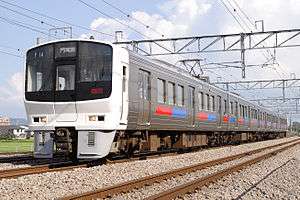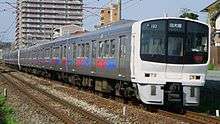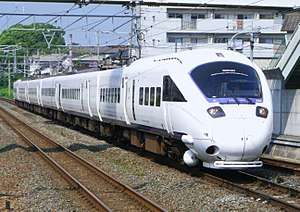811 series
| 811 series | |
|---|---|
 An 811-0 series set in September 2009 | |
| Manufacturer | Hitachi, Kinki Sharyo, JR Kyushu |
| Replaced | 421 series |
| Constructed | 1989–1993 |
| Entered service | 21 July 1989 |
| Refurbishment | 2017– |
| Number built | 112 vehicles (28 sets) |
| Number in service | 108 vehicles (27 sets) |
| Number scrapped | 4 vehicles (1 set) |
| Formation | 4 cars per trainset |
| Operator(s) | JR Kyushu |
| Depot(s) | Minami-Fukuoka |
| Line(s) served | Kagoshima Main Line, Nagasaki Main Line, Nippo Main Line |
| Specifications | |
| Car body construction | Stainless steel |
| Car length | 20,000 mm (65 ft 7 in) |
| Width | 2,950 mm (9 ft 8 in) |
| Height | 3,670 mm (12 ft 0 in) |
| Doors | 3 pairs per side |
| Maximum speed | 120 km/h (75 mph) |
| Traction system |
Thyristor drive Variable frequency (SiC) (811-1500 series) |
| Electric system(s) | 20 kV AC 60 Hz |
| Current collection method | Overhead catenary |
| Multiple working | 813/815/817 series |
| Track gauge | 1,067 mm (3 ft 6 in) |
The 811 series (811系) is an AC electric multiple unit (EMU) train type operated on local services by Kyushu Railway Company (JR Kyushu) in Japan since 1989.[1]
Variants
- 811-0 series: 16 x 4-car sets (PM1–17)
- 811-100 series: 11 x 4-car sets (PM101–111)
- 811-1500 series: Refurbished 4-car sets (PM15xx)
Design
The trains were built jointly by Hitachi, Kinki Sharyo, and JR Kyushu (Kokura factory).[2]
Operations
811 series trains are used on "Local" (all-stations) and "Rapid" (limited-stop) services on the following lines.[3]
Formations
As of 1 October 2017, the fleet consists of 108 vehicles, formed as 27 four-car sets.[4]
811-0 series
The four-car 811-0 series sets (sets PM1 to PM17) are formed as follows.[4]
| Designation | M'c | M | T | Tc' |
|---|---|---|---|---|
| Numbering | KuMoHa 810 | MoHa 811 | SaHa 811 | KuHa 810 |
| Capacity (Seated/total) | 48/124 | 56/133 | 56/133 | 44/123 |
The KuMoHa 810 car is fitted with one PS101Q lozenge-type pantograph. The KuHa 810 car has a toilet.[4]
811-100 series

The four-car 811-100 series sets (sets PM101 to PM111) are formed as follows.[4]
| Designation | M'c | M | T | Tc' |
|---|---|---|---|---|
| Numbering | KuMoHa 810-1xx | MoHa 811-1xx | SaHa 811-1xx | KuHa 810-1xx |
| Capacity (Seated/total) | 48/133 | 56/141 | 56/141 | 44/131 |
The KuMoHa 810 car is fitted with one PS101Q lozenge-type pantograph. The KuHa 810 car has a toilet.[4] Sets PM105 and PM106 have SaHa 811-200 cars instead of SaHa 811-100 cars. These also have a toilet.[4]
811-1500 series

The four-car 811-1500 series sets (sets PM15xx) refurbished from former 811-0 series sets are formed as follows.[4]
| Designation | M'c | M | T | Tc' |
|---|---|---|---|---|
| Numbering | KuMoHa 810-15xx | MoHa 811-15xx | SaHa 811-15xx | KuHa 810-15xx |
The KuMoHa 810 car is fitted with one single-arm pantograph. The KuHa 810 car has a toilet.[4]
Interior
The 811-100 series sets have fixed transverse seats in the vicinity of the doorways rather than the flip-over seats of the 811-0 series sets.[4]
 The interior of 811-0 series set PM11 in November 2008
The interior of 811-0 series set PM11 in November 2008 The interior of 811-100 series car KuHa 810-106 of set PM106 in November 2006
The interior of 811-100 series car KuHa 810-106 of set PM106 in November 2006 The interior of refurbished 811-1500 series car MoHa 811-1504 of set PM1504 in September 2017
The interior of refurbished 811-1500 series car MoHa 811-1504 of set PM1504 in September 2017
Livery variations
Sets P8 and P9 carried a "Mitsui Greenland" promotional livery, and set P11 carried a "Space World" promotional livery for a while. As of January 2013, P8 carries promotional vinyls for the Kyushu Heritage Museum, and the other two sets have been returned to the standard colour scheme.[5]
 Set P9 in Mitsui Greenland livery in April 2006
Set P9 in Mitsui Greenland livery in April 2006 Set P11 in Space World livery in September 2006
Set P11 in Space World livery in September 2006- Set P8 in promotional livery in April 2011
History
The first sets were delivered in June 1989, and entered service from 21 July 1989.[5] Trains became all no-smoking from 1 September 1995.[6]
11 811-100 series four-car sets were delivered from 1992, numbered PM101 to PM111.[5] These had a modified seating arrangement to provide more standing space in the doorway areas.[5]
Refurbishment

In 2017, set PM4 was refurbished, renumbered as set PM1504. Refurbishment changes include replacing the traction control equipment with SiC-VVVF equipment, changing to a single-arm pantograph, tinted passenger windows, full-colour LED destination indicators, and replacement of the former transverse seating with longitudinal bench seating.[7] The interior and exterior design for refurbished trainsets was overseen by the industrial design company Don Design Associates.[8] The first refurbished trainset returned to service in April 2017.[8]
References
| Wikimedia Commons has media related to 811 series. |
- ↑ JR全車輌ハンドブック2009 [JR Rolling Stock Handbook 2009]. Japan: Neko Publishing. 2009. pp. 322–323. ISBN 978-4-7770-0836-0.
- ↑ Saka, Masahiro (March 2014). JR第1世代の車両・現況と概要 [JR 1st-generation rolling stock: Current situation and overview]. Tetsudō Daiya Jōhō Magazine (in Japanese). Japan: Kotsu Shimbun. 43 (359): 22.
- ↑ Haraguchi, Takayuki (2009). Encyclopedia of JR's Railway Cars: JR全車輌. Japan: Sekai Bunka. p. 95. ISBN 978-4-418-09905-4.
- 1 2 3 4 5 6 7 8 9 JR電車編成表 2018冬 [JR EMU Formations - Winter 2018] (in Japanese). Japan: Kotsu Shimbunsha. 15 November 2017. p. 217. ISBN 978-4-330-84117-5.
- 1 2 3 4 Saka, Masahiro (February 2013). JR九州近郊型電車の現況 [The current state of JR Kyushu outer-suburban EMUs]. Tetsudō Daiya Jōhō Magazine (in Japanese). Japan: Kotsu Shimbun. 42 (346): 14–31.
- ↑ JR電車編成表 '98夏号 [JR EMU Formations - Summer 1998]. Japan: JRR. July 1998. p. 175. ISBN 4-88283-029-9.
- ↑ 811系リニューアル第1号編成が出場 [First refurbished 811 series set outshopped]. RM News (in Japanese). Japan: Neko Publishing Co., Ltd. 4 April 2017. Archived from the original on 4 April 2017. Retrieved 4 April 2017.
- 1 2 811系リニューアル車,4月27日から営業運転を開始 [Refurbished 811 series train to enter revenue service from 27 April]. Japan Railfan Magazine Online (in Japanese). Japan: Koyusha Co., Ltd. 26 April 2017. Archived from the original on 26 April 2017. Retrieved 26 April 2017.
